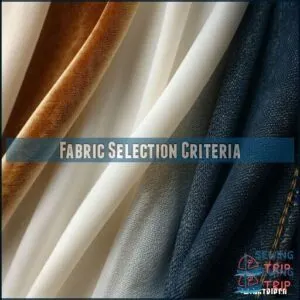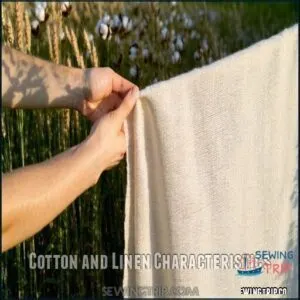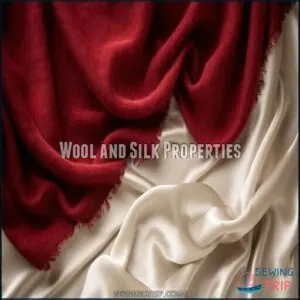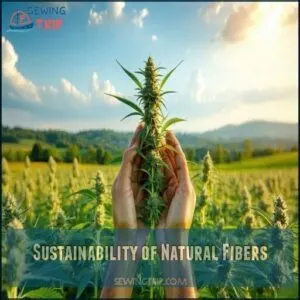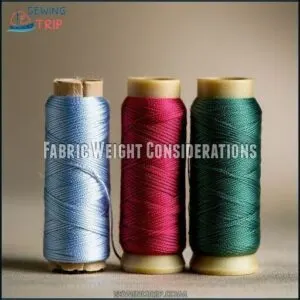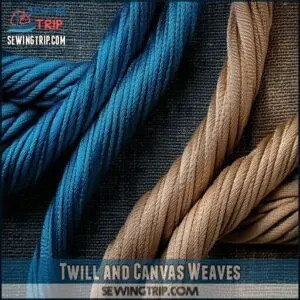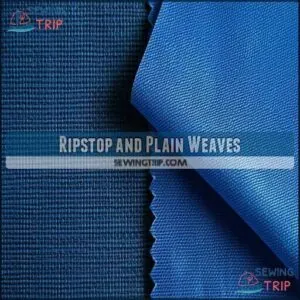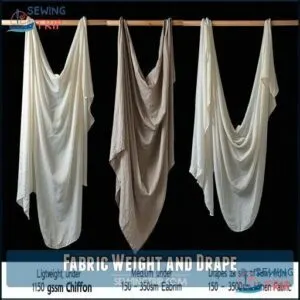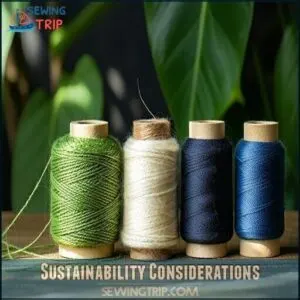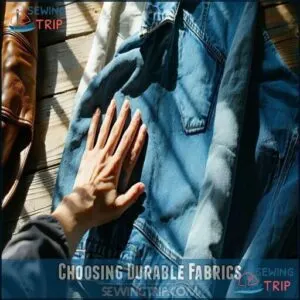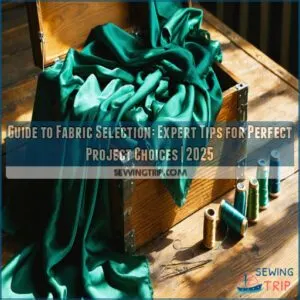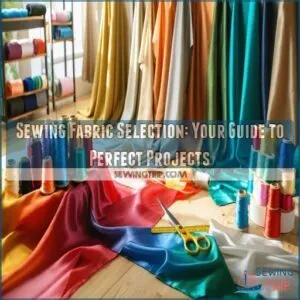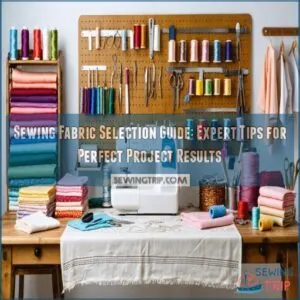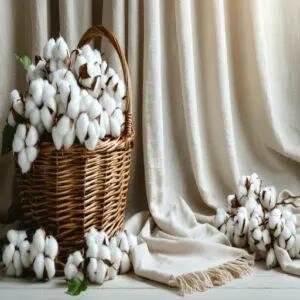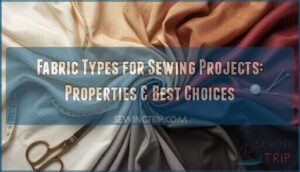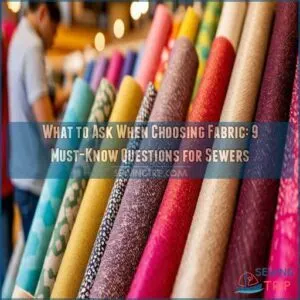This site is supported by our readers. We may earn a commission, at no cost to you, if you purchase through links.
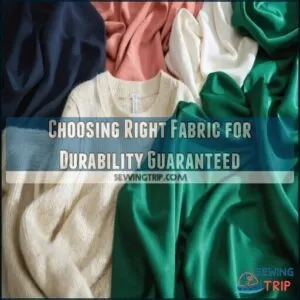
Synthetic fibers like polyester and nylon are your workout warriors, while natural fibers like cotton and wool keep things comfy and breathable.
Think of fabric weight as your durability compass – lightweight for summer breezes, medium-weight for everyday heroes, and heavyweight when you need serious muscle.
Look for tight weaves like twill or ripstop that’ll stand up to life’s adventures.
And here’s a little secret: sustainable options like recycled polyester and organic cotton aren’t just earth-friendly – they’re built to last like champions too.
Table Of Contents
Key Takeaways
- You’ll get the best durability from synthetic fibers like polyester and nylon – they resist wrinkles, maintain shape after washing, and handle stains better than natural materials.
- Your fabric weight choice matters significantly – go with lightweight (under 150 GSM) for summer wear, medium weight (150-350 GSM) for everyday clothing, and heavyweight (above 350 GSM) for structured outerwear.
- You’ll want to look for tight weaves like twill, canvas, and ripstop – these constructions prevent tearing and increase the fabric’s overall strength and longevity.
- You’re not sacrificing durability by choosing sustainable options – materials like recycled polyester and organic cotton offer both environmental benefits and long-lasting performance.
Fabric Selection Criteria
You’re about to choose the perfect fabric for your clothing, and it’s important to evaluate factors like breathability, softness, and durability.
By evaluating these criteria, you’ll be able to select a fabric that meets your needs and guarantee your clothes last longer, saving you time and money in the long run, which is crucial for durability.
Breathability and Moisture-Wicking
When choosing fabric, consider breathability and moisture-wicking properties for comfort.
Look for fabrics with good air circulation, sweat evaporation, and moisture management, like cotton or linen, which offer great fabric breathability and wicking performance, regulating temperature and keeping you cool with moisture-wicking properties.
Softness and Comfort
Beyond breathability, comfort matters! Softness and comfort depend on the fabric’s hand feel, fiber properties, and drape.
Choosing the right fabric impacts comfort, and you can learn more about fabric selection criteria.
Consider these softness factors:
- Fiber properties (like cotton’s softness)
- Fabric drape (how it flows)
- Hand feel (is it smooth or rough?)
- Comfort levels (especially for sensitive skin)
Durability and Longevity
You want durable clothes, so consider fiber strength, wear resistance, and tear prevention.
Learn about durable fabric options like twill, canvas, and ripstop.
| Fabric | Durability |
|---|---|
| Cotton | 8/10 |
| Polyester | 9/10 |
| Linen | 8.5/10 |
Follow longevity tips for long-lasting clothes, like proper fabric care.
Color Fastness and Aesthetic
You consider color fastness and aesthetic when picking fabrics, ensuring color retention and wash fastness for garment durability.
While color psychology impacts aesthetic appeal, and lightfastness affects clothing longevity, all contributing to overall fabric durability.
Natural Fibers Benefits
You’re looking for fabrics that will make your clothes last, and natural fibers are a great choice.
Natural fibers like cotton, wool, and silk offer breathability, comfort, and a touch of luxury that’s hard to beat, so let’s explore their benefits.
Cotton and Linen Characteristics
You’re looking at cotton and linen for natural fibers.
Linen boasts remarkable linen fabric properties.
- Breathability comfort
- Fiber properties
- Cultivating cotton
- Linen production
- Durability comparison, making them great for clothing durability, with cotton and linen being top choices for fabric durability.
Wool and Silk Properties
You’ll love wool’s warmth and silk’s smoothness, offering great fiber strength.
Wool and silk fabrics have unique drape characteristics, requiring specific care instructions to maintain durability, making them great natural fiber options for your projects, with wool providing warmth and silk offering smoothness and elegance.
For more details, explore this wool versus cashmere comparison.
Sustainability of Natural Fibers
While wool and silk offer luxurious comfort, natural fibers bring impressive environmental benefits too.
You’ll find organic cotton and hemp fiber require less water and zero harmful chemicals during production. These sustainable fabrics break down completely in landfills, unlike synthetics that stick around for centuries.
Plus, natural fibers from regenerative agriculture actually help restore soil health – it’s like giving Mother Nature a high-five while getting durable clothes!
Many natural fibers are hypoallergenic, making them a comfortable choice for sensitive skin, which is also good for the environment.
Synthetic Fibers Advantages
You’ll find synthetic fibers like polyester and nylon working harder than a gym teacher on field day, offering exceptional durability that withstands countless washes and wear.
These wonder fabrics aren’t just tough cookies – they’re also quick to dry, resist wrinkles better than a pampered cat, and maintain their shape even after marathon washing sessions, which makes them quick to recover.
Polyester and Nylon Features
While natural fibers offer comfort, synthetic alternatives like polyester and nylon pack quite a punch in the durability department.
Many manufacturers use durable polyester fabrics for a variety of products.
You’ll find these fabrics are true workhorses in your wardrobe, offering:
- Outstanding water resistance that keeps you dry during unexpected rain showers
- Remarkable wrinkle resistance for that fresh-from-the-closet look
- Superior stain resistance against coffee spills and food mishaps
- Easy care properties that make laundry day a breeze
These synthetic fibers maintain their shape and strength, making them perfect for active wear.
Acrylic and Fleece Benefits
You’ll find synthetic wonders in acrylic and fleece, offering incredible warmth without breaking the bank.
These cozy alternatives to wool provide exceptional softness and easy care, making them perfect for everyday wear.
Acrylic’s durability shines in sweaters and blankets, while fleece’s plush comfort wraps you like a cloud.
The fabric properties of both synthetics are designed to retain their shape and softness through countless washes, providing incredible warmth and easy care.
Durability of Synthetic Fibers
After exploring acrylic’s cozy benefits, you’ll be amazed by synthetic fibers’ incredible durability.
These tough materials outperform natural options in three key ways:
- They’re highly elastic and resist stretching, keeping your clothes looking fresh longer
- They handle stains and heat like a champ, making maintenance a breeze
- They’re substantially longer-lasting than natural alternatives, saving you money in the long run
Your synthetic fabric choices will keep performing beautifully, wash after wash, due to their highly elastic nature.
Fabric Weight Considerations
You’ll find that fabric weight, measured in grams per square meter (GSM), plays a huge role in how long your clothes will last, just like choosing the right tires for your car.
When you’re picking out fabric, you can easily match the weight to your needs: lightweight fabrics under 150 GSM for breezy summer wear, medium weights of 150-350 GSM for everyday clothes.
And heavyweight options above 350 GSM for sturdy outerwear that’ll handle whatever life throws at you.
Lightweight Fabrics for Summer
While synthetic fibers shine in durability, you’ll want to switch gears for summer comfort.
Let’s explore the best lightweight fabrics that’ll keep you cool without sacrificing strength.
| Fabric Type | Key Features |
|---|---|
| Cotton Voile | Ultra-light, breathable |
| Linen Blends | Moisture-wicking, airy |
| Silk Chiffon | Featherweight, elegant |
| Mesh Cotton | Quick-drying, ventilated |
| Bamboo Jersey | Cool-touch, sustainable |
These fabrics weigh under 150 GSM, perfect for those scorching days when you’re feeling like a popsicle in the sun, and are made of breathable materials that provide summer comfort with ultra-light properties.
Medium Weight Fabrics for Everyday
While light fabrics keep you cool in summer, medium weight fabrics (150-350 GSM) hit the sweet spot for everyday wear.
A thorough fabric weight guide offers more detailed information.
You’ll love how these versatile materials balance comfort with fabric durability. Think of them as your wardrobe’s reliable middle child – not too light, not too heavy.
They’re perfect for year-round clothing, offering excellent breathability while maintaining their shape. With proper care, they’ll be your faithful companions through countless adventures, providing excellent comfort.
Heavyweight Fabrics for Structure
In pursuit of garments that stand tall and proud, heavyweight fabrics offer unmatched structure and support.
You’ll love how these sturdy materials like canvas and denim hold their shape beautifully.
Here’s what makes heavyweight fabrics your best choice:
- Corduroy and tweed provide excellent insulation while maintaining a polished look
- Leather and thick canvas deliver superior durability for workwear
- Dense denim creates long-lasting clothing that ages gracefully
Fabric Types and Weaves
You’ll find that understanding fabric types and weaves is like having a secret map to clothing that lasts, with each pattern serving a unique purpose in the durability game.
When you’re picking out clothes, remember that sturdy weaves like twill, canvas, and ripstop are your best friends, working hard to keep your garments strong and ready for action.
Twill and Canvas Weaves
Explore the universe of fabric weaves, where twill and canvas each bring unique strengths to your clothing.
You’ll find twill’s distinctive diagonal pattern offers superior flexibility and comfort, while maintaining impressive durability.
Canvas, with its simple "over-under" construction, delivers unmatched sturdiness for heavy-duty needs.
Think of twill as your flexible friend and canvas as your reliable stronghold in the fabric family, where durability is key.
Ripstop and Plain Weaves
While twill and canvas have their strengths, you’ll find ripstop weave‘s unique crosshatch pattern acts like a built-in safety net for your fabric.
You can spot ripstop by its distinctive grid of reinforcement threads that stop tears in their tracks.
Plain weave, on the other hand, keeps things simple with its over-under pattern that’s stood the test of time – it’s basically the classic blue jeans of fabric construction.
Fabric Weight and Drape
Beyond weave patterns, understanding fabric weight and drape can make or break your garment’s success.
You’ll notice how fabric weight categories directly affect Visual Impact and Garment Flow.
- Lightweight fabrics (under 150 GSM) float like butterflies, perfect for flowing summer dresses
- Medium weight fabrics (150-350 GSM) balance structure with movement
- Heavyweight fabrics (over 350 GSM) hold their shape, ideal for structured coats
Fabric Hand determines how material falls and moves with your body
Sustainability Considerations
You’ll love how today’s eco-friendly fabrics don’t just help Mother Earth but also last longer in your closet, from organic cotton that feels like a cloud to recycled polyester that’s tough as nails.
By choosing sustainable materials like hemp canvas or recycled nylon, you’re reducing waste and also getting garments that can handle whatever life throws at them.
Eco-Friendly Fibers and Materials
You’ll love how eco-friendly fibers combine comfort with environmental care.
Organic cotton leads the pack, grown without harsh pesticides, while hemp fabric offers incredible durability that gets better with age.
Bamboo linen and sustainable silk provide luxurious alternatives that keep our planet happy.
Look for TENCEL Lyocell, a game-changing material made from sustainable wood pulp – it’s like wearing a cloud while hugging trees!
Recycled and Biodegradable Options
Many sustainable options are transforming yesterday’s waste into tomorrow’s wardrobe.
You’ll find recycled polyester from plastic bottles and bio-based nylon made from plant materials leading the charge.
Consider browsing recycled polyester clothing options available online.
Recycled cotton and biodegradable silk offer eco-friendly alternatives that decompose naturally.
Don’t overlook sustainable hemp and other recycled fabrics – they’re not just good for the planet, they’re surprisingly durable too.
It’s like giving fabric a second chance at life!
Ethical Production and Low-Impact
When you’re choosing sustainable fabrics, don’t forget about the human touch behind every stitch.
Fair Trade practices and worker wellbeing go hand-in-hand with reduced emissions and waste reduction. Learn about sustainable sewing fabrics like organic cotton and hemp.
You’ll find ecofriendly fabrics that tell amazing stories of sustainable sourcing and ethical production.
- Look for certifications like Fair Trade and GOTS (Global Organic Textile Standard)
- Support brands that provide living wages and safe working conditions
- Check for transparent supply chains that showcase ethical sourcing methods
Choosing Durable Fabrics
You’ll discover that choosing the right fabric is like picking a trusty sidekick for your clothes, where durability becomes your superpower against wear and tear.
Whether you’re looking at sturdy denims or reliable cotton blends, you’ll learn the secrets to spot fabrics that won’t let you down, even after countless washes and adventures.
Identifying High-Quality Fabrics
Looking at high-quality fabrics is like detective work – you’ll want to check specific clues.
Start by examining the thread count and fiber content through touch and sight. Quality fabrics gather smoothly in your hand and show even texture throughout.
Run your fingers along the surface – superior materials resist manipulation and maintain consistent texture.
Natural fibers like cotton and silk often signal premium durability and luxurious feel.
Pre-Washing and Shrinking Prevention
Smart fabric care starts with prewashing to prevent unwanted shrinkage surprises.
You’ll want to test swatches first, then follow these proven steps for shrink prevention:
- Always wash cold water for delicate fabrics
- Skip the dryer – air dry flat or hang
- Check garment labels for preshrunk fabric indicators
- Avoid hot water washing that can damage fibers
This washing strategy keeps your clothes fitting perfectly, wash after wash.
Frequently Asked Questions (FAQs)
What is the most durable fabric for clothing?
With denim accounting for 90% of durable clothing sales, it’s your best bet for long-lasting wear.
You’ll find that denim, followed by tightly-woven cotton and wool, offers exceptional strength and resilience for daily use.
What are the 4 things to consider when choosing fabric?
You’ll want to evaluate your fabric’s durability, breathability, comfort, and care requirements. Think about how often you’ll wear it, what activities you’ll do, and whether it’s easy to maintain.
What fabric tends to be more durable with?
You’ll find that tightly woven fabrics like denim, canvas, and twill offer superior durability.
These heavy-duty materials can withstand regular wear and tear, making them perfect for your everyday clothing needs, with superior durability being a key benefit.
How to choose the right fabric for clothes?
Consider your garment’s purpose and choose fabrics that match.
You’ll need breathable cotton for everyday wear, durable denim for workwear, or luxurious silk for special occasions.
Always check the fabric’s weight and care instructions.
How do different climates affect fabric choice?
Like a chameleon adapts to its surroundings, you’ll need different fabrics for different climates.
You’ll want light cotton or linen for hot weather, while wool’s warmth serves you well in cold conditions.
Can fabric allergies influence clothing durability decisions?
Your fabric allergies directly impact clothing longevity.
When you’re allergic to certain fibers, you’ll wash clothes more frequently to remove allergens, which can wear them out faster.
Natural alternatives often last longer.
What role does body temperature play in fabric selection?
Just as your home’s thermostat adjusts for comfort, your body needs fabrics that regulate temperature.
You’ll want breathable materials like cotton when you’re warm and insulating ones like wool when you’re cool.
How do activity levels impact fabric wear patterns?
Your movement determines where clothes experience the most stress.
Running creates friction at thighs and armpits, while lifting weights strains shoulders and back.
That’s why you’ll need durable, flexible fabrics for exercise.
Should price determine fabric quality and longevity expectations?
Money isn’t always the golden ticket to quality.
You’ll find mid-priced fabrics that outlast expensive ones when you focus on fiber content, weave density, and construction rather than price tag alone.
Conclusion
Just as a master chef selects the finest ingredients, choosing the right fabric for clothing durability is an art worth mastering.
You’ve now got the recipe for success: from sturdy synthetics to breathable naturals, and from lightweight summer choices to heavy-duty options.
Remember, quality fabric is your garment’s foundation. Whether you’re picking eco-friendly materials or traditional favorites, use these tips to make informed choices that’ll keep your wardrobe looking fresh and lasting longer.
Your clothes will thank you!
- https://www.fabricsight.com/blogs/posts/the-top-3-most-durable-fabrics-you-should-know-about
- https://icefabrics.com/blogs/news/factors-to-consider-when-choosing-a-fabric
- https://www.dishafashioninstitute.com/fabric-selection-for-garments
- https://searchforfabric.com/blogs/search-for-fabric-blog/the-importance-of-high-quality-fabric-for-clothing-a-guide-to-elevating-your-wardrobe
- https://www.ie-uk.com/blog/long-lasting-natural-fabrics-for-the-workplace

